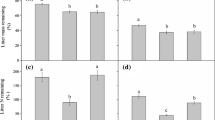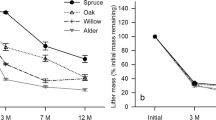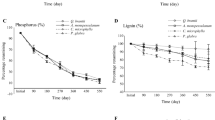Abstract
Human activities affect both tree species composition and diversity in forested ecosystems. This in turn alters the species diversity of plant litter and litter quality, which may have cascading effects on soil microbial communities and their functions for decomposition and nutrient cycling. We tested microbial responses to litter species diversity in a leaf litter decomposition experiment including monocultures, 2-, and 4-species mixtures in the subtropical climate zone of southeastern China. Soil microbial community composition was assessed by lipid analysis, and microbial functions were measured using extracellular enzyme activity and gross rates of nitrogen mineralization. We observed a positive relationship between litter species diversity and abundances of mycorrhizal fungi and actinomycetes. Alternatively, enzyme activities involved in carbon and phosphorus acquisition, and enzyme indices of relative carbon limitation, were higher only in the 4-species mixtures. This suggests that the minimum basal substrate level for enzyme production was reached, or that limitation was higher, at the highest diversity level only. Responses to litter diversity also changed over time, where phosphatase responses to litter diversity were strongest early in decomposition and the indices of carbon limitation relative to other nutrients showed stronger responses later in decomposition. Enzyme activities were related to lipid biomarker data and the mass of litter remaining at the third time point, but relationships between enzyme activity and the mass of litter remaining were not consistent across other time points. We conclude that litter species richness will likely only reduce microbial functions at key intervals of diversity loss while microbial growth is more sensitive to incremental diversity loss, with no clear relationships between them or to ecosystem functions. The observed litter diversity effects on soil microbial biomass and enzyme activity indicate interactions of aboveground and belowground communities, and together with environmental conditions they are important for maintaining ecosystem functions.






Similar content being viewed by others
References
Allison SD, Vitousek PM (2005) Responses of extracellular enzymes to simple and complex nutrient inputs. Soil Biol Biochem 37:937–944. doi:10.1016/j.soilbio.2004.09.014
Balser TC, Treseder KK, Ekenler M (2005) Using lipid analysis and hyphal length to quantify AM and saprotrophic fungal abundance along a soil chronosequence. Soil Biol Biochem 37:601–604. doi:10.1016/j.soilbio.2004.08.019
Bandick AK, Dick RP (1999) Field management effects on soil enzyme activities. Soil Biol Biochem 31:1471–1479. doi:10.1016/s0038-0717(99)00051-6
Bardgett RD, Shine A (1999) Linkages between plant litter diversity, soil microbial biomass and ecosystem function in temperate grasslands. Soil Biol Biochem 31:317–321. doi:10.1016/s0038-0717(98)00121-7
Bell C, Stromberger M, Wallenstein M (2013) New insights into enzymes in the environment. Biogeochemistry 117:1–4. doi:10.1007/s10533-013-9935-0
Berg B, McClaugherty C (2008) Plant litter: decomposition, humus formation, carbon sequestration, 2nd edn. Springer, Berlin
Bobbink R et al (2010) Global assessment of nitrogen deposition effects on terrestrial plant diversity: a synthesis. Ecol Appl 20:30–59. doi:10.1890/08-1140.1
Brockett BFT, Prescott CE, Grayston SJ (2012) Soil moisture is the major factor influencing microbial community structure and enzyme activities across seven biogeoclimatic zones in western Canada. Soil Biol Biochem 44:9–20. doi:10.1016/j.soilbio.2011.09.003
Burns RG et al (2013) Soil enzymes in a changing environment: current knowledge and future directions. Soil Biol Biochem 58:216–234. doi:10.1016/j.soilbio.2012.11.009
Caldwell BA (2005) Enzyme activities as a component of soil biodiversity: a review. Pedobiologia 49:637–644. doi:10.1016/j.pedobi.2005.06.003
Conn C, Dighton J (2000) Litter quality influences on decomposition, ectomycorrhizal community structure and mycorrhizal root surface acid phosphatase activity. Soil Biol Biochem 32:489–496. doi:10.1016/s0038-0717(99)00178-9
Cornelissen JHC, Thompson K (1997) Functional leaf attributes predict litter decomposition rate in herbaceous plants. New Phytol 135:109–114. doi:10.1046/j.1469-8137.1997.00628.x
Davidson EA, Hart SC, Firestone MK (1992) Internal cycling of nitrate in soils of a mature coniferous forest. Ecology 73:1148. doi:10.2307/1940665
Eisenhauer N et al (2010) Plant diversity effects on soil microorganisms support the singular hypothesis. Ecology 91:485–496. doi:10.1890/08-2338.1
Falcón MA, Rodríguez A, Carnicero A, Regalado V, Perestelo F, Milstein O, De la Fuente G (1995) Isolation of microorganisms with lignin transformation potential from soil of Tenerife island. Soil Biol Biochem 27:121–126. doi:10.1016/0038-0717(94)00174-y
Fierer N, Schimel JP, Holden PA (2003) Variations in microbial community composition through two soil depth profiles. Soil Biol Biochem 35:167–176. doi:10.1016/s0038-0717(02)00251-1
Fischer H, Mille-Lindblom C, Zwirnmann E, Tranvik LJ (2006) Contribution of fungi and bacteria to the formation of dissolved organic carbon from decaying common reed (Phragmites australis). Arch Hydrobiol 166:79–97. doi:10.1127/0003-9136/2006/0166-0079
Frey SD, Elliott ET, Paustian K, Peterson GA (2000) Fungal translocation as a mechanism for soil nitrogen inputs to surface residue decomposition in a no-tillage agroecosystem. Soil Biol Biochem 32:689–698. doi:10.1016/s0038-0717(99)00205-9
Frossard A, Gerull L, Mutz M, Gessner MO (2012) Disconnect of microbial structure and function: enzyme activities and bacterial communities in nascent stream corridors. ISME J 6:680–691. doi:10.1038/ismej.2011.134
Frostegård A, Bååth E (1996) The use of phospholipid fatty acid analysis to estimate bacterial and fungal biomass in soil. Biol Fertil Soils 22:59–65
Galloway JN et al (2008) Transformation of the nitrogen cycle: recent trends, questions, and potential solutions. Science 320:889–892. doi:10.1126/science.1136674
García-Palacios P, Maestre FT, Kattge J, Wall DH, Klironomos J (2013) Climate and litter quality differently modulate the effects of soil fauna on litter decomposition across biomes. Ecol Lett 16:1045–1053. doi:10.1111/ele.12137
Gartner TB, Cardon ZG (2004) Decomposition dynamics in mixed-species leaf litter. Oikos 104:230–246. doi:10.1111/j.0030-1299.2004.12738.x
German DP, Chacon SS, Allison SD (2011) Substrate concentration and enzyme allocation can affect rates of microbial decomposition. Ecology 92:1471–1480. doi:10.1890/10-2028.1
Gutknecht JLM, Field CB, Balser TC (2012) Microbial communities and their responses to simulated global change fluctuate greatly over multiple years. Glob Change Biol 18:2256–2269. doi:10.1111/j.1365-2486.2012.02686.x
Hansen RA (2000) Effects of habitat complexity and composition on a diverse litter microarthropod assemblage. Ecology 81:1120–1132. doi:10.1890/0012-9658(2000)081[1120:eohcac]2.0.co;2
Hart SC, Stark JM, Davidson EA, Firestone MK (1994) Nitrogen Mineralization, immobilization, and nitrification. In: Bottomley PS, Angle JS, Weaver RW (eds) Methods of soil analysis: part 2—microbiological and biochemical properties. SSSA Book Series, vol 5.2. Soil Science Society of America, Madison, pp 985–1018. doi:10.2136/sssabookser5.2.c42
Hector A, Beale AJ, Minns A, Otway SJ, Lawton JH (2000) Consequences of the reduction of plant diversity for litter decomposition: effects through litter quality and microenvironment. Oikos 90:357–371. doi:10.1034/j.1600-0706.2000.900217.x
Hodge A, Campbell CD, Fitter AH (2001) An arbuscular mycorrhizal fungus accelerates decomposition and acquires nitrogen directly from organic material. Nature 413:297–299. doi:10.1038/35095041
Hooper DU et al (2000) Interactions between aboveground and belowground biodiversity in terrestrial ecosystems: patterns, mechanisms, and feedbacks. Bioscience 50:1049. doi:10.1641/0006-3568(2000)050[1049:ibaabb]2.0.co;2
Hu YL, Wang SL, Zeng DH (2006) Effects of single Chinese fir and mixed leaf litters on soil chemical, microbial properties and soil enzyme activities. Plant Soil 282:379–386. doi:10.1007/s11104-006-0004-5
IUSS Working Group WRB (2015) World reference base for soil resources 2014, update 2015. International soil classification system for naming soils and creating legends for soil maps. World Soil Resources Reports No. 106. FAO, Rome
Janssen BH (1996) Nitrogen mineralization in relation to C:N ratio and decomposability of organic materials. Plant Soil 181:39–45. doi:10.1007/bf00011290
Jenkins M (2003) Prospects for biodiversity. Science 302:1175–1177. doi:10.1126/science.1088666
Jiang J, Li Y, Wang M, Zhou C, Cao G, Shi P, Song M (2013) Litter species traits, but not richness, contribute to carbon and nitrogen dynamics in an alpine meadow on the Tibetan Plateau. Plant Soil 373:931–941. doi:10.1007/s11104-013-1859-x
Johnsen AR, Jacobsen OS (2008) A quick and sensitive method for the quantification of peroxidase activity of organic surface soil from forests. Soil Biol Biochem 40:814–821. doi:10.1016/j.soilbio.2007.10.017
Kaiser C et al (2010) Belowground carbon allocation by trees drives seasonal patterns of extracellular enzyme activities by altering microbial community composition in a beech forest soil. New Phytol 187:843–858. doi:10.1111/j.1469-8137.2010.03321.x
Kaneko N, Salamanca E (1999) Mixed leaf litter effects on decomposition rates and soil microarthropod communities in an oak-pine stand in Japan. Ecol Res 14:131–138. doi:10.1046/j.1440-1703.1999.00292.x
Kellner H, Luis P, Zimdars B, Kiesel B, Buscot F (2008) Diversity of bacterial laccase-like multicopper oxidase genes in forest and grassland Cambisol soil samples. Soil Biol Biochem 40:638–648. doi:10.1016/j.soilbio.2007.09.013
Kourtev PS, Ehrenfeld JG, Huang WZ (2002) Enzyme activities during litter decomposition of two exotic and two native plant species in hardwood forests of New Jersey. Soil Biol Biochem 34:1207–1218. doi:10.1016/s0038-0717(02)00057-3
Kurzatkowski D, Martius C, Höfer H, Garcia M, Förster B, Beck L, Vlek P (2004) Litter decomposition, microbial biomass and activity of soil organisms in three agroforestry sites in central Amazonia. Nutr Cycl Agroecosyst 69:257–267. doi:10.1023/b:fres.0000035196.19804.13
Lecerf A, Marie G, Kominoski JS, LeRoy CJ, Bernadet C, Swan CM (2011) Incubation time, functional litter diversity, and habitat characteristics predict litter-mixing effects on decomposition. Ecology 92:160–169. doi:10.1890/10-0315.1
Lummer D, Scheu S, Butenschoen O (2012) Connecting litter quality, microbial community and nitrogen transfer mechanisms in decomposing litter mixtures. Oikos 121:1649–1655. doi:10.1111/j.1600-0706.2011.20073.x
McArthur JV, Aho JM, Rader RB, Mills GL (1994) Interspecific leaf interactions during decomposition in aquatic and floodplain ecosystems. J N Am Benthol Soc 13:57. doi:10.2307/1467265
McGuire KL, Treseder KK (2010) Microbial communities and their relevance for ecosystem models: decomposition as a case study. Soil Biol Biochem 42:529–535. doi:10.1016/j.soilbio.2009.11.016
McKinley VL, Peacock AD, White DC (2005) Microbial community PLFA and PHB responses to ecosystem restoration in tallgrass prairie soils. Soil Biol Biochem 37:1946–1958. doi:10.1016/j.soilbio.2005.02.033
Moorhead DL, Sinsabaugh RL (2006) A theoretical model of litter decay and microbial interaction. Ecol Monogr 76:151–174. doi:10.1890/0012-9615(2006)076[0151:atmold]2.0.co;2
Moorhead DL, Rinkes ZL, Sinsabaugh RL, Weintraub MN (2013) Dynamic relationships between microbial biomass, respiration, inorganic nutrients and enzyme activities: informing enzyme-based decomposition models. Front Microbiol 4:223. doi:10.3389/fmicb.2013.00223
Moorhead DL, Sinsabaugh RL, Hill BH, Weintraub MN (2016) Vector analysis of ecoenzyme activities reveal constraints on coupled C, N and P dynamics. Soil Biol Biochem 93:1–7. doi:10.1016/j.soilbio.2015.10.019
Ngosong C, Gabriel E, Ruess L (2012) Use of the signature fatty acid 16:1ω5 as a tool to determine the distribution of arbuscular mycorrhizal fungi in soil. J Lipids 2012:1–8. doi:10.1155/2012/236807
Oksanen J et al (2013) Vegan: community ecology package. R package version 20-9 doi:http://CRAN.R-project.org/package=vegan
Östman Ö, Drakare S, Kritzberg ES, Langenheder S, Logue JB, Lindstrom ES (2010) Regional invariance among microbial communities. Ecol Lett 13:118–127. doi:10.1111/j.1461-0248.2009.01413.x
Pei Z et al (2016) Soil and tree species traits both shape soil microbial communities during early growth of Chinese subtropical forests. Soil Biol Biochem 96:180–190. doi:10.1016/j.soilbio.2016.02.004
Prober SM et al (2015) Plant diversity predicts beta but not alpha diversity of soil microbes across grasslands worldwide. Ecol Lett 18:85–95. doi:10.1111/ele.12381
Purahong W et al (2014) Uncoupling of microbial community structure and function in decomposing litter across beech forest ecosystems in Central Europe. Sci Rep 4:7014. doi:10.1038/srep07014
R Development Core Team (2013) R: a language and environment for statistical computing. R Foundation for Statistical Computing, Vienna, Austria. http://www.rproject.org
Recous S, Machet JM, Mary B (1992) The partitioning of fertilizer-N between soil and crop: comparison of ammonium and nitrate applications. Plant Soil 144:101–111. doi:10.1007/bf00018850
Reich PB, Oleksyn J (2004) Global patterns of plant leaf N and P in relation to temperature and latitude. Proc Natl Acad Sci USA 101:11001–11006. doi:10.1073/pnas.0403588101
Rinkes ZL, Weintraub MN, DeForest JL, Moorhead DL (2011) Microbial substrate preference and community dynamics during decomposition of Acer saccharum. Fungal Ecol 4:396–407. doi:10.1016/j.funeco.2011.01.004
Rinkes ZL, DeForest JL, Grandy AS, Moorhead DL, Weintraub MN (2013) Interactions between leaf litter quality, particle size, and microbial community during the earliest stage of decay. Biogeochemistry 117:153–168. doi:10.1007/s10533-013-9872-y
Rosseel Y (2012) lavaan: AnR Package for structural equation modeling. J Stat Softw. doi:10.18637/jss.v048.i02
Sanders FE, Tinker PB (1973) Phosphate flow into mycorrhizal roots. Pestic Sci 4:385–395. doi:10.1002/ps.2780040316
Schmid B, Baruffol M, Wang Z, Niklaus PA (2017) A guide to analyzing biodiversity experiments. J Plant Ecol 10:91–110. doi:10.1093/jpe/rtw107
Scholten T et al (2017) On the combined effect of soil fertility and topography on tree growth in subtropical forest ecosystems—a study from SE China. J Plant Ecol 10:111–127. doi:10.1093/jpe/rtw065
Scott NA, Binkley D (1997) Foliage litter quality and annual net N mineralization: comparison across North American forest sites. Oecologia 111:151–159. doi:10.1007/s004420050219
Seitz S et al (2015) The influence of leaf litter diversity and soil fauna on initial soil erosion in subtropical forests. Earth Surf Proc Land 40:1439–1447. doi:10.1002/esp.3726
Sinsabaugh RL, Antibus RK, Linkins AE (1991) An enzymic approach to the analysis of microbial activity during plant litter decomposition. Agr Ecosyst Environ 34:43–54. doi:10.1016/0167-8809(91)90092-c
Sinsabaugh RL et al (2008) Stoichiometry of soil enzyme activity at global scale. Ecol Lett 11:1252–1264. doi:10.1111/j.1461-0248.2008.01245.x
Sinsabaugh RL et al (2014) Extracellular enzyme kinetics scale with resource availability. Biogeochemistry 121:287–304. doi:10.1007/s10533-014-0030-y
Stange CF, Spott O, Apelt B, Russow RW (2007) Automated and rapid online determination of 15 N abundance and concentration of ammonium, nitrite, or nitrate in aqueous samples by the SPINMAS technique. Isot Environ Health Stud 43:227–236. doi:10.1080/10256010701550658
Steinauer K et al (2015) Plant diversity effects on soil microbial functions and enzymes are stronger than warming in a grassland experiment. Ecology 96:99–112. doi:10.1890/14-0088.1
Stursova M, Crenshaw CL, Sinsabaugh RL (2006) Microbial responses to long-term N deposition in a semiarid grassland. Microb Ecol 51:90–98. doi:10.1007/s00248-005-5156-y
Trogisch S, He J-S, Hector A, Scherer-Lorenzen M (2015) Impact of species diversity, stand age and environmental factors on leaf litter decomposition in subtropical forests in China. Plant Soil 400:337–350. doi:10.1007/s11104-015-2737-5
Vahdat E, Nourbakhsh F, Basiri M (2011) Lignin content of range plant residues controls N mineralization in soil. Eur J Soil Biol 47:243–246. doi:10.1016/j.ejsobi.2011.05.001
van der Heijden MG, Bardgett RD, van Straalen NM (2008) The unseen majority: soil microbes as drivers of plant diversity and productivity in terrestrial ecosystems. Ecol Lett 11:296–310. doi:10.1111/j.1461-0248.2007.01139.x
Větrovský T, Steffen KT, Baldrian P (2014) Potential of cometabolic transformation of polysaccharides and lignin in lignocellulose by soil Actinobacteria. PLoS ONE 9:e89108. doi:10.1371/journal.pone.0089108
Vitousek PM, Matson PA (1988) Nitrogen transformations in a range of tropical forest soils. Soil Biol Biochem 20:361–367. doi:10.1016/0038-0717(88)90017-x
Wang J, Bu W, Zhao B, Zhao X, Zhang C, Fan J, Gadow K (2015) Effects of nitrogen addition on leaf decomposition of single-species and litter mixture in Pinus tabulaeformis forests. Forests 6:4462–4476. doi:10.3390/f6124381
Wardle DA (2006) The influence of biotic interactions on soil biodiversity. Ecol Lett 9:870–886. doi:10.1111/j.1461-0248.2006.00931.x
Wardle DA, Bonner KI, Nicholson KS (1997) Biodiversity and plant litter: experimental evidence which does not support the view that enhanced species richness improves ecosystem function. Oikos 79:225–247. doi:10.2307/3546010
Wardle DA, Nilsson M-C, Zackrisson O, Gallet C (2003) Determinants of litter mixing effects in a Swedish boreal forest. Soil Biol Biochem 35:827–835. doi:10.1016/s0038-0717(03)00118-4
Waring BG (2013) Exploring relationships between enzyme activities and leaf litter decomposition in a wet tropical forest. Soil Biol Biochem 64:89–95. doi:10.1016/j.soilbio.2013.04.010
Wilkinson S (2002) PLFA profiles of microbial communities in decomposing conifer litters subject to moisture stress. Soil Biol Biochem 34:189–200. doi:10.1016/s0038-0717(01)00168-7
Wu YT et al (2012) Relationships between soil microorganisms, plant communities, and soil characteristics in Chinese subtropical forests. Ecosystems 15:624–636. doi:10.1007/s10021-012-9533-3
Wu J, Liu W, Fan H, Huang G, Wan S, Yuan Y, Ji C (2013a) Asynchronous responses of soil microbial community and understory plant community to simulated nitrogen deposition in a subtropical forest. Ecol Evol 3:3895–3905. doi:10.1002/ece3.750
Wu YT, Wubet T, Trogisch S, Both S, Scholten T, Bruelheide H, Buscot F (2013b) Forest age and plant species composition determine the soil fungal community composition in a Chinese subtropical forest. PLoS ONE 8:e66829. doi:10.1371/journal.pone.0066829
Yang X et al (2013) Establishment success in a forest biodiversity and ecosystem functioning experiment in subtropical China (BEF-China). Eur J Forest Res 132:593–606. doi:10.1007/s10342-013-0696-z
Yanni SF, Whalen JK, Simpson MJ, Janzen HH (2011) Plant lignin and nitrogen contents control carbon dioxide production and nitrogen mineralization in soils incubated with Bt and non-Bt corn residues. Soil Biol Biochem 43:63–69. doi:10.1016/j.soilbio.2010.09.012
Zhang JB, Cai ZC, Zhu TB, Yang WY, Muller C (2013) Mechanisms for the retention of inorganic N in acidic forest soils of southern China. Sci Rep 3:2342. doi:10.1038/srep02342
Acknowledgements
We thank all the members of NILEX group (within Biodiversity and Ecosystem Function-China Project) as well as the field helpers for their efforts for establishing and maintaining the field plots. We thank Yvonne Eckstein and Ann-Kathrin Blank for their help with lipid analysis and Kantida Juncheed for her help in enzyme activity measurement. We thank also Oliver Spott and Bernd Apelt for their help with N mineralization rates measurements. We thank Peter Kühn, Steffen Seitz and Philipp Goebes for providing the basic soil data. This work was funded by German Research Foundation (DFG) (Research Unit FOR 891/2, BU941/24-2, GU 1237/1-1) and by University of Minnesota internal faculty startup funds.
Author information
Authors and Affiliations
Corresponding author
Additional information
Responsible Editor: E. Matzner.
Electronic supplementary material
Below is the link to the electronic supplementary material.
Rights and permissions
About this article
Cite this article
Pei, Z., Leppert, K.N., Eichenberg, D. et al. Leaf litter diversity alters microbial activity, microbial abundances, and nutrient cycling in a subtropical forest ecosystem. Biogeochemistry 134, 163–181 (2017). https://doi.org/10.1007/s10533-017-0353-6
Received:
Accepted:
Published:
Issue Date:
DOI: https://doi.org/10.1007/s10533-017-0353-6




